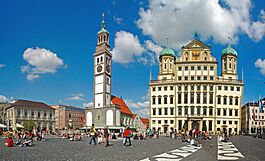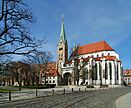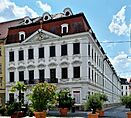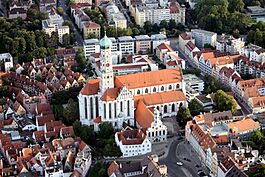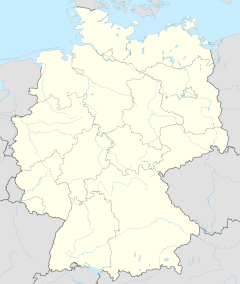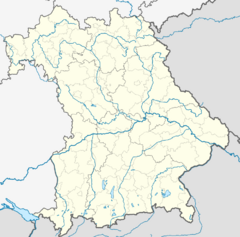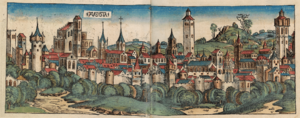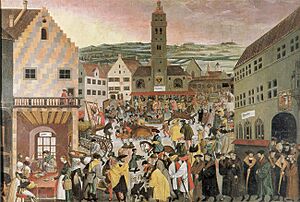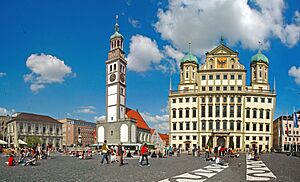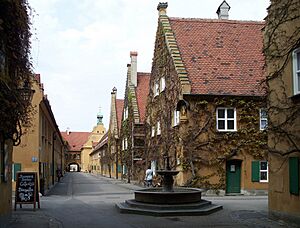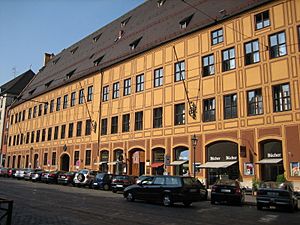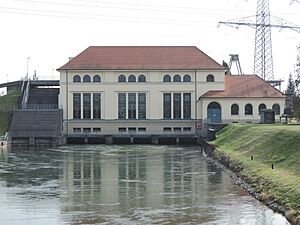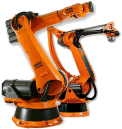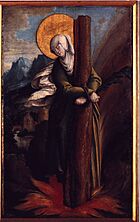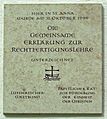Augsburg facts for kids
Quick facts for kids
Augsburg
Ougschburg (Swabian)
|
|||
|---|---|---|---|
|
From top: Perlachturm (left); Augsburg Town Hall (right); Maximilian Museum; Fuggerei; Augsburg Cathedral; Schaezlerpalais; and Basilica of SS. Ulrich and Afra
|
|||
|
|||
| Country | Germany | ||
| State | Bavaria | ||
| Admin. region | Swabia | ||
| District | Urban district | ||
| Area | |||
| • City | 146.84 km2 (56.70 sq mi) | ||
| Elevation | 494 m (1,621 ft) | ||
| Population
(2022-12-31)
|
|||
| • City | 301,033 | ||
| • Density | 2,050.07/km2 (5,309.67/sq mi) | ||
| • Metro | 885,000 | ||
| Time zone | UTC+01:00 (CET) | ||
| • Summer (DST) | UTC+02:00 (CEST) | ||
| Postal codes |
86150–86199
|
||
| Dialling codes | 0821 | ||
| Vehicle registration | A | ||
Augsburg is a historic city in the Bavarian part of Swabia, Germany. It is about 50 kilometers (31 miles) west of Munich, the capital of Bavaria. Augsburg is a university town with a beautiful and well-preserved old city center, called the Altstadt. It is the third-largest city in Bavaria, after Munich and Nuremberg. About 304,000 people live in Augsburg.
Augsburg is one of Germany's oldest cities. The Romans founded it in 15 BC as Augusta Vindelicorum. It was named after the Roman emperor Augustus. From 1276 to 1803, Augsburg was a Free Imperial City, meaning it was self-governing. It was home to the rich Fugger and Welser families, who were very important in European banking in the 1500s. The city was a major center for early capitalism. It also played a big role in the Reformation. The Augsburg Confession was presented here in 1530, and the Peace of Augsburg was signed in 1555. The Fuggerei, the world's oldest social housing complex, was started by Jakob Fugger in 1513.
In 2019, UNESCO named Augsburg's Water Management System a World Heritage Site. This was because of its special medieval canals and water towers. They show how water engineering developed over time.
Contents
- Geography: Where is Augsburg?
- History: A Look Back in Time
- Climate: Augsburg's Weather
- Main Sights: What to See in Augsburg
- Population: How Many People Live Here?
- Twin Towns: Augsburg's Sister Cities
- Transport: Getting Around Augsburg
- Economy: Augsburg's Industries
- Education: Learning in Augsburg
- Media: News in Augsburg
- Notable People: Famous Faces from Augsburg
- Sports: Augsburg's Teams
- Local City Nicknames
- Images for kids
- See also
Geography: Where is Augsburg?
Augsburg is located where the Alpine rivers Lech and Wertach meet. The city also sits on the Singold river. The oldest parts of the city are on a high terrace. This area is between the hills of Friedberg to the east and high hills to the west. To the south is the Lechfeld, a flat plain formed after the ice age. This area has rare, untouched landscapes.
Augsburg is next to the Augsburg Western Woods. This is a large forest area. The city itself has many green spaces. In 1997, Augsburg was the first German city to win the Entente Florale contest. This award is for Europe's greenest and most livable city.
Nearby Towns and Villages
Augsburg is surrounded by the Landkreis Augsburg to the west and Aichach-Friedberg to the east.
Some of the towns near Augsburg are Friedberg, Königsbrunn, Stadtbergen, Neusäß, Gersthofen, and Diedorf.
History: A Look Back in Time
Early Beginnings
The city of Augsburg was founded in 15 BC. This happened under the orders of Emperor Augustus. The Roman settlement was called Augusta Vindelicorum. This means "the Augustan city of the Vindelici". It was built where the Lech and Wertach rivers meet. In 120 AD, Augsburg became the main city of the Roman province of Raetia. Over the centuries, Augsburg was attacked several times. The Huns, Charlemagne, and Welf I, Duke of Bavaria all attacked the city.
Becoming a Free City and the Reformation
Augsburg became a Free Imperial City on March 9, 1276. This meant it was independent from its former ruler, the Prince-Bishop of Augsburg. Augsburg was in a great location for trade routes to Italy. This helped it become a major trading center.
The city was known for making woven goods and textiles. Two very rich banking families, the Fuggers and the Welsers, lived here. The Fugger family started the Fuggerei in 1516. This was a special area to provide homes for people in need. It is still used today.
In 1530, the Augsburg Confession was presented to the Holy Roman Emperor. This was a key document of the Protestant Reformation. After the Peace of Augsburg in 1555, religious groups had legal protection. Augsburg had a mixed Catholic and Protestant city council.
A Center of Trade and Art
Augsburg's economy grew a lot in the 1400s and 1500s. This was thanks to the banking and metal businesses of the Fugger, Welser, and Hochstetter families. These families had a lot of control over important industries. Even though some people criticized their business methods, Emperor Charles V needed their money. In the 1500s, Augsburg became one of Germany's largest cities.
Augsburg was a big center for making textiles, armor, and scientific instruments. It was also known for gold and silver work. Printers in Augsburg made the city the biggest producer of German-language books. As a free city, Augsburg could set its own tax rules.
The city's wealth attracted many artists. Augsburg quickly became a creative hub for sculptors and musicians. The Holbein family of artists started here. The famous composer Leopold Mozart was born and grew up in Augsburg. The Rococo art style became so popular here that it was called "Augsburg style" in Germany. Augsburg also benefited from the Kaiserliche Reichspost. This was the first modern postal service in the world. Augsburg became the most important post office location in the Holy Roman Empire.
The Thirty Years' War
Religious peace in Augsburg lasted until the Thirty Years' War (1618–1648). In 1632, Gustavus Adolphus of Sweden took over Augsburg. In 1634, the Swedish army lost a battle nearby. Catholic troops then surrounded Augsburg. The city was under siege through the winter of 1634-1635. Thousands of people died from hunger and disease. The city's population dropped from about 70,000 to 16,000.
Skilled Craftsmen
In the early 1600s, Augsburg was very important for goldsmiths in Europe. Many goldsmiths came to Augsburg to learn and become masters. In the 1700s, many skilled silversmiths and goldsmiths worked in the city.
The League of Augsburg
In 1686, Holy Roman Emperor Leopold I formed the League of Augsburg. This group included Austria, Bavaria, England, and other countries. They joined together to defend against France in the Nine Years' War.
Losing Independence
In 1803, many Free Imperial Cities lost their independence. Augsburg was one of the last to remain free. However, when the Holy Roman Empire ended in 1806, Augsburg lost its independence. It became part of the Kingdom of Bavaria.
Industrial Growth
In the late 1800s, Augsburg's textile industry became important again. After that, the machine manufacturing industry also grew.
World War II and Beyond
Augsburg was a key military city because of its location. During World War II, the MAN factory in Augsburg made engines. The factory was bombed several times during the war. About 25% of the homes in the city were destroyed. Many people also died.
In 1941, Rudolf Hess secretly flew from an Augsburg airport to Scotland. He hoped to meet with the Duke of Hamilton. He wanted to try and end the war in Europe. After the war, American military forces were stationed in Augsburg during the Cold War. They returned the barracks to Germany in 1998.
Climate: Augsburg's Weather
Augsburg has a mild climate. Summers are generally warm, and winters are cool. It gets a good amount of rain throughout the year.
| Climate data for Augsburg (1991–2020 normals) | |||||||||||||
|---|---|---|---|---|---|---|---|---|---|---|---|---|---|
| Month | Jan | Feb | Mar | Apr | May | Jun | Jul | Aug | Sep | Oct | Nov | Dec | Year |
| Mean daily maximum °C (°F) | 3.0 (37.4) |
4.8 (40.6) |
9.5 (49.1) |
14.5 (58.1) |
18.8 (65.8) |
22.2 (72.0) |
24.2 (75.6) |
24.1 (75.4) |
19.1 (66.4) |
13.6 (56.5) |
7.1 (44.8) |
3.7 (38.7) |
13.7 (56.7) |
| Daily mean °C (°F) | −0.1 (31.8) |
0.7 (33.3) |
4.4 (39.9) |
8.8 (47.8) |
13.2 (55.8) |
16.6 (61.9) |
18.3 (64.9) |
18.0 (64.4) |
13.4 (56.1) |
8.9 (48.0) |
3.9 (39.0) |
0.8 (33.4) |
8.9 (48.0) |
| Mean daily minimum °C (°F) | −3.2 (26.2) |
−3.2 (26.2) |
−0.3 (31.5) |
2.8 (37.0) |
7.2 (45.0) |
10.7 (51.3) |
12.2 (54.0) |
11.9 (53.4) |
8.0 (46.4) |
4.6 (40.3) |
0.7 (33.3) |
−2.2 (28.0) |
4.1 (39.4) |
| Average precipitation mm (inches) | 45.1 (1.78) |
34.1 (1.34) |
47.3 (1.86) |
45.8 (1.80) |
84.8 (3.34) |
92.0 (3.62) |
94.3 (3.71) |
91.8 (3.61) |
61.9 (2.44) |
52.9 (2.08) |
50.2 (1.98) |
49.7 (1.96) |
749.4 (29.50) |
| Average precipitation days (≥ 0.1 mm) | 14.9 | 14.2 | 14.8 | 12.4 | 14.7 | 16.0 | 15.4 | 14.2 | 13.2 | 14.3 | 14.4 | 16.8 | 175.3 |
| Average snowy days (≥ 1.0 cm) | 10.8 | 10.1 | 3.7 | 0.3 | 0 | 0 | 0 | 0 | 0 | 0.1 | 2.7 | 7.4 | 38.1 |
| Average relative humidity (%) | 86.2 | 82.5 | 78.0 | 72.5 | 72.9 | 73.8 | 73.4 | 74.9 | 81.1 | 85.5 | 89.2 | 88.2 | 79.8 |
| Mean monthly sunshine hours | 61.8 | 88.1 | 138.3 | 186.4 | 211.9 | 228.0 | 243.8 | 230.2 | 162.8 | 106.6 | 55.9 | 54.1 | 1,768.5 |
| Source: NOAA | |||||||||||||
Main Sights: What to See in Augsburg
Augsburg has many interesting places to visit:
- Town Hall: Built in 1620 in the Renaissance style. It has a famous room called the Goldener Saal (Golden Hall).
- Perlachturm: A tall bell tower built in 989.
- Fuggerei: The world's oldest social housing complex. People have lived here since 1523.
- Fuggerhäuser (Fugger houses): Beautiful Renaissance palaces that belonged to the Fugger banking family.
- Bishop's Residence: Built around 1750. Today, it is the main office for the region of Swabia.
- Cathedral: Founded in the 800s.
- St Anne's Church: A medieval church built in 1321.
- Augsburg Synagogue: One of the few German synagogues that survived World War II. It is now restored and has a Jewish museum.
- Augsburg textile and industry museum (tim): A museum about textiles and industry.
- Schaezlerpalais: A beautiful Rococo mansion from 1765. It now holds a major art museum.
- St Ulrich and St Afra: Two churches standing side-by-side. One is Catholic, the other is Lutheran. This shows the religious peace from the Peace of Augsburg in 1555.
- Mozart Haus Augsburg: The house where Leopold Mozart, the father of Mozart, was born. Mozart himself visited here.
- Augsburger Puppenkiste: A famous puppet theater.
- Luther Stiege: A museum in a church that shows the life of Martin Luther.
- Eiskanal: The world's first artificial whitewater course. It was used for the 1972 Munich Olympics.
- Childhood home of Bertolt Brecht.
- The Augsburg Botanical Gardens.
- Maximillian Museum: A museum of decorative arts.
- Bahnpark Augsburg: Home to 29 historic trains, a blacksmith, and a historic roundhouse.
- Three magnificent Renaissance fountains: the Augustus Fountain, Mercury Fountain, and Hercules Fountain. They were built in the 1500s.
- Walter Art Museum at the Glas Palast (Glass Palace).
- Roman Museum: Located in the former Monastery of St Magdalena. It is currently undergoing renovation.
- Medieval canals: These canals were used for industries, making weapons, and providing clean water.
- Kulturhaus Abraxas.
Augsburg's Water Management System
Augsburg's water systems have been very innovative for centuries. The city is built over an underground water source. This source is fed by the Lech and Wertach rivers. It provides clean groundwater that flows through the city. Canals for this water were first mentioned in 1276. By 1416, waterworks, pumps, and water towers were added to move the water around.
In 1545, Augsburg was one of the first European cities to separate drinking water from water used by industries. This helped prevent water-borne diseases. The pumps and waterwheels also created power for fountains and food processing. For example, a butcher's hall from the 1600s still stands today. In the 1800s and 1900s, hydroelectric power plants were built. These were some of the first in the world to make electricity from water. They are still used today. On July 6, 2019, UNESCO named the Water Management System of Augsburg a World Heritage Site.
Population: How Many People Live Here?
Augsburg has a population of about 300,000 people. It is the third-largest city in Bavaria. It is also the biggest city in the Swabia region. In the 1500s, Augsburg was one of the largest cities in the Holy Roman Empire. It had about 30,000 people, similar to cities like Cologne and Prague. Augsburg reached 100,000 residents in 1909. Its population has been growing steadily since then.
| Largest groups of foreign residents | |
| Nationality | Population (31 December 2022) |
|---|---|
| 11,701 | |
| 7,242 | |
| 5,382 | |
| 4,280 | |
| 4,123 | |
| 2,581 | |
| 2,332 | |
| 2,249 | |
| 2,169 | |
| 2,107 | |
| 1,823 | |
| 1,650 | |
Twin Towns: Augsburg's Sister Cities
Augsburg is connected with these cities around the world:
Transport: Getting Around Augsburg
Roads
The main highway is A 8. This road connects Munich and Stuttgart.
Public Transport
Augsburg has a great public transport system. It is managed by the Augsburger Verkehrs- und Tarifverbund (AVV). This system covers central Swabia. There are seven local train lines, five tram lines, 27 city bus lines, and six night bus lines. There are also many taxi companies.
The Augsburg tramway network is 35.5 kilometers (22 miles) long. New lines have opened to the university and the hospital. In December 2021, tram line 3 was extended to Königsbrunn.
Intercity Bus
Augsburg has one station for long-distance buses. It is called Augsburg Nord and is in the north of the city.
Railway
Augsburg has seven train stations. The main one is the Central Station (Hauptbahnhof). It was built from 1843 to 1846. It is Germany's oldest main station in a large city that still uses its original building. The Central Station connects Augsburg to major cities like Munich, Berlin, and Frankfurt. You can also take high-speed trains like the French TGV to Paris.
The AVV operates seven local train lines from the main station. These lines connect to nearby towns like Mammendorf and Donauwörth. There are plans to make these services more frequent, like an S-Bahn system.
Air Transport
Until 2005, Augsburg was served by the nearby Augsburg Airport (AGB). Now, all passenger flights use Munich Airport. Augsburg Airport is mostly used by business airplanes.
Economy: Augsburg's Industries

Augsburg is a busy industrial city. Many world-leading companies are here. Companies like MAN, EADS, and KUKA make high-tech products. These include printing systems, large engines, industrial robots, and parts for the Airbus A380 and Ariane rockets. Augsburg is seen as a high-tech center for Information and Communication in Bavaria. It has lower costs but is still close to Munich. In 2018, the Bavarian State Government recognized Augsburg as a "Metropole" (major city).
Major Companies in Augsburg
- Boewe Systec
- Faurecia
- Fujitsu Technology Solutions
- KUKA Robotics / Systems
- MAN (Maschinenfabrik Augsburg-Nürnberg)
- manroland
- MT-Aerospace (formerly MAN Technologie)
- NCR
- Osram
- Premium AEROTEC
- RENK AG (part of MAN SE)
- Siemens
- UPM-Kymmene (formerly Haindl)
- WashTec (formerly Kleindienst)
- Synlab Group
- Cancom
- Check24
- Amazon
- Patrizia Immobilien
Education: Learning in Augsburg
Augsburg is home to these universities and colleges:
- University of Augsburg: Founded in 1970.
- Technische Hochschule Augsburg (University of Applied Sciences).
Media: News in Augsburg
The local newspaper in Augsburg is the Augsburger Allgemeine. It was first published in 1807.
Notable People: Famous Faces from Augsburg
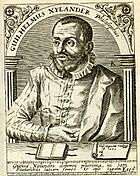
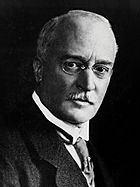
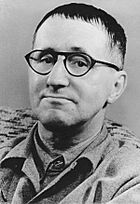
Many famous people have come from Augsburg:
- Saint Afra (died 304): The patron saint of Augsburg.
- Saint Ulrich (around 890–973): A bishop.
- Jakob Fugger (1459–1525): A very important banker. He started the Fuggerei for the poor.
- Hans Holbein the Elder (1460–1524): A painter who helped change German art.
- Hans Holbein the Younger (1497–1543): A famous portrait painter.
- Elias Holl (1573–1646): A well-known architect.
- Leopold Mozart (1719–1787): A violinist and composer. He was the father of Wolfgang Amadeus Mozart.
- Rudolf Diesel (1858–1913): The inventor of the diesel engine.
- Bertolt Brecht (1898–1956): A famous writer and theater director.
- Mietek Pemper (1920–2011): He helped save 1,200 Jewish prisoners during the Holocaust.
- Wolf Blitzer (born 1948): An American journalist for CNN.
- Sheryl Lee (born 1967): An actress.
- Andreas Bourani (born 1983): A singer-songwriter.
Sports Stars from Augsburg

- Helmut Haller (1939–2012): A famous footballer who played for West Germany in three World Cups.
- Bernhard Langer (born 1957): A professional golfer.
- Bernd Schuster (born 1959): A football coach and former player.
- Philipp Kohlschreiber (born 1983): A former tennis player.
- Stefan Bradl (born 1989): A motorcycle racer.
- Nico Sturm (born 1995): An ice hockey player.
Sports: Augsburg's Teams
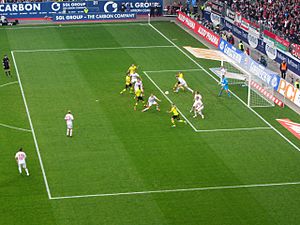
FC Augsburg is the city's football team. They play in the WWK ARENA. FC Augsburg was promoted to the Bundesliga in 2011 and has stayed there. In 2015, they qualified for the Europa League for the first time. The WWK ARENA opened in 2009 and also hosted games for the 2011 FIFA Women's World Cup.
Augsburg also has an ice hockey team called the Augsburger Panther. They play in the top German league, the DEL. The club, AEV, was formed in 1878. It is the oldest German ice sport club. Their home games are at the Curt Frenzel Stadion. The Panthers qualified for the Champions Hockey League in 2018/19.
The city is also home to the Augsburg Gators, a traditional German Baseball club. There are also two American Football clubs, the Raptors and Augsburg Storm. In nearby Königsbrunn, you can find the Königsbrunn Ants.
For the 1972 Olympic Games in Munich, a channel of the Lech river was turned into the world's first artificial whitewater slalom course. This is the Eiskanal. It is still a top competition venue today.
Local City Nicknames
Augsburg is often called Fuggerstadt (Fuggers' city). This is because the Fuggers lived there. In the Swabia region, it is also called Datschiburg. This name comes from Augsburg's favorite sweet treat, the Datschi. It is made from fruit, usually plums, on a thin cake dough. The Datschiburger Kickers charity football team, founded in 1965, uses this nickname.
Younger people sometimes call the city "Aux" for short.
Images for kids
See also
 In Spanish: Augsburgo para niños
In Spanish: Augsburgo para niños


